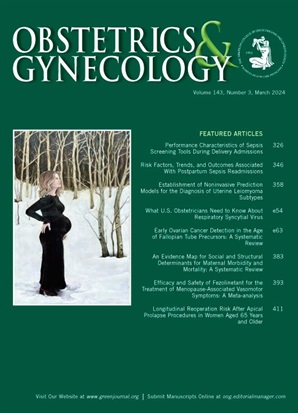泌尿妇科手术后恢复性生活的干预咨询:一项随机对照试验。
IF 4.7
2区 医学
Q1 OBSTETRICS & GYNECOLOGY
引用次数: 0
摘要
目的比较干预对盆腔器官脱垂(POP)或尿失禁(UI)手术患者术后恢复性生活准备的影响,并与常规的第一次性行为咨询进行比较。方法:该多中心随机临床试验招募了计划在POP或UI手术后性生活活跃的个体;患者在术后6 - 8周随机接受干预或常规咨询。主要结果是准备好重返性活动。如果患者在6分的李克特量表中回答“总体而言,我觉得我准备好在手术后恢复性活动”,那么他们就被认为做好了准备。术后每隔1个月至6个月与参与者进行联系;当他们报告恢复性活动时,他们完成了准备和疼痛量表以及PISQ-IR(骨盆器官脱垂/尿失禁性问卷,iuga修订)。结果186例患者中,170例(91.4%)完成随访并纳入分析。在6个月内重返性活动的准备程度上没有差异。然而,在干预咨询后6至8周,存在差异。随机分配到干预咨询组的患者报告称,恢复性活动的准备程度较高(比值比[OR] 2.42, 95% CI, 1.03-5.65),经历性交困难的可能性较低(比值比[OR] 0.27, 95% CI, 0.09-0.86),并且更早恢复性活动(风险比1.46,95% CI, 1.06-2.01)。干预前,57例(33.5%)患者恢复了性行为。在其余113名参与者的敏感性分析中,干预咨询与术后6-8周的更大准备相关(81.0% vs 56.9%,调整OR 4.82, 95% CI, 1.66-13.99)。结论:与常规咨询相比,针对POP或UI术后恢复性活动的干预咨询与改善患者恢复性活动时的准备无关,但确实改善了6-8周的准备并减少了性交困难。尽管有咨询,但近三分之一的参与者在术后6-8周内恢复了性行为。临床试验注册:clinicaltrials .gov, NCT05342090。本文章由计算机程序翻译,如有差异,请以英文原文为准。
Intervention Counseling for Return to Sex After Urogynecologic Surgery: A Randomized Controlled Trial.
OBJECTIVE
To compare the effect of intervention on patients' postoperative preparedness to return to sexual activity after pelvic organ prolapse (POP) or urinary incontinence (UI) surgery compared with the usual counseling regarding the first sexual encounter.
METHODS
This multicenter randomized clinical trial recruited individuals who were planning to be sexually active after surgery for POP or UI; the patients who were randomized to intervention or usual counseling at 6 to 8 weeks postoperatively. The primary outcome was preparedness to return to sexual activity. Patients were considered prepared if they answered "strongly agree" or "agree" on a 6-point Likert scale to the statement, "Overall, I feel prepared for resuming sexual activity after my surgery." Participants were contacted at 1-month intervals up to 6 months postoperatively; when they reported return to sexual activity, they completed preparedness and pain scales and the PISQ-IR (Pelvic Organ Prolapse/Urinary Incontinence Sexual Questionnaire, IUGA-Revised).
RESULTS
Of 186 patients, 170 (91.4%) completed follow-up and were included in the analyses. There was no difference in preparedness to return to sexual activity, at the time of returning to sexual activity within 6 months. However, there were differences noted 6 to 8 weeks after the intervention counseling. Patients randomized to intervention counseling reported higher preparedness to return to sexual activity (odds ratio [OR] 2.42, 95% CI, 1.03-5.65), lower likelihood of experiencing dyspareunia (OR 0.27, 95% CI, 0.09-0.86), and an earlier return to sexual activity (hazard ratio 1.46, 95% CI, 1.06-2.01). Before the intervention, 57 (33.5%) patients returned to sexual activity. In sensitivity analysis of the remaining 113 participants, intervention counseling remained associated with greater preparedness at 6-8 weeks postoperatively (81.0% vs 56.9%, adjusted OR 4.82, 95% CI, 1.66-13.99).
CONCLUSION
Intervention counseling regarding return to sexual activity after surgeries for POP or UI was not associated with improved patient preparedness at the time of return to sexual activity but did improve preparedness and decrease dyspareunia at 6-8 weeks, compared with usual counseling. Despite counseling otherwise, nearly a third of participants returned to sexual activity before 6-8 weeks postoperatively.
CLINICAL TRIAL REGISTRATION
ClinicalTrials.gov, NCT05342090.
求助全文
通过发布文献求助,成功后即可免费获取论文全文。
去求助
来源期刊

Obstetrics and gynecology
医学-妇产科学
CiteScore
11.10
自引率
4.20%
发文量
867
审稿时长
1 months
期刊介绍:
"Obstetrics & Gynecology," affectionately known as "The Green Journal," is the official publication of the American College of Obstetricians and Gynecologists (ACOG). Since its inception in 1953, the journal has been dedicated to advancing the clinical practice of obstetrics and gynecology, as well as related fields. The journal's mission is to promote excellence in these areas by publishing a diverse range of articles that cover translational and clinical topics.
"Obstetrics & Gynecology" provides a platform for the dissemination of evidence-based research, clinical guidelines, and expert opinions that are essential for the continuous improvement of women's health care. The journal's content is designed to inform and educate obstetricians, gynecologists, and other healthcare professionals, ensuring that they stay abreast of the latest developments and best practices in their field.
 求助内容:
求助内容: 应助结果提醒方式:
应助结果提醒方式:


